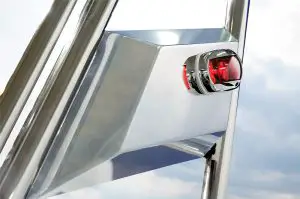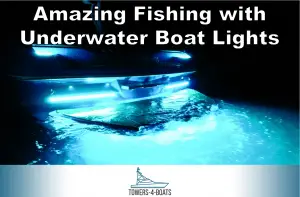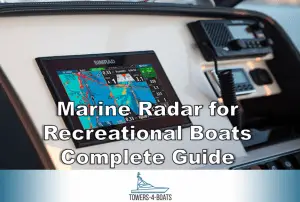Why Are Navigation Lights Important?
For some sailors, navigation lights seem like an optional feature to make sailing easier and safer. However, anyone accustomed to sailing at night or during periods of low visibility will tell you that proper navigation lighting is a must. Commercial vessels are required by law to have navigation lights, but recreational boats fall within a grey area. Without good navigation lighting, your boat runs the risk of colliding with rocks, docks or even another vessel. You also might find yourself lost on what could have been a simple, short expedition.
Navigation lights are one of the most important safety devices on your boat. They alert other boats to your presence and allow vessels to avoided collisions. Regardless of whether your boat came with lights or not, you are legally required to have the proper type and configuration.
So, do you know what navigation lights the law requires you to display? Is your boat equipped with the right navigation lights for its size, and do you know when you’re required to turn them on? In this article, we unpack everything you need to know about navigation lights, as well as some frequently asked questions, so that you can sail safely and danger-free this boating season. From basic rules and regulations to your responsibilities as a boat-owner, we cover everything to keep you, your passengers and everyone else on the water safe. If you want to avoid getting lost with your family, check out my article on navigation.
What Do Navigation Lights Do?
Simply put, navigation lights allow you to see other vessels and obstacles in the water, and they allow other vessels to see you. They light up everything in your field of vision during tricky times of obstructed and reduced visibility. By doing this, they prevent collisions and keep everyone on the water safe. Your crew, your passengers and other vessels all benefit from the information that navigation lights provide when out on the water. For example, navigation lights can tell you the size of an approaching vessel, what’s going on in the water closest to your vessel and what direction you need to sail in to avoid a collision. All of this illuminating information allows you to arrive at your destination safe and sound.
Your boat won’t get very far without navigation lights. If you are caught by law enforcement sailing without them, you may find yourself with a hefty fine. Even worse, you endanger the lives of anyone else on the water when you sail without navigation lights. Your vessel’s visibility truly is a matter of life or death. Therefore, it’s your responsibility to always use the proper navigation lights for your vessel.
Basic Lighting Rules and Laws
 Understanding your boat’s needs requires a quick look at basic navigation light law. As a rule of thumb, the United States Coast Guard states that you must have the appropriate navigation lights on anytime visibility is low–think nighttime, fog or anytime your field of vision is severely limited.
Understanding your boat’s needs requires a quick look at basic navigation light law. As a rule of thumb, the United States Coast Guard states that you must have the appropriate navigation lights on anytime visibility is low–think nighttime, fog or anytime your field of vision is severely limited.
All of the navigation lights on your vessel will have a specific location, color, range of visibility and arc of illumination that you must comply with in order to follow the law. To make sure your lights are up to par, follow these basic rules for navigation lights:
- Stern lights and all-around lights must be white. While your all-around lights must cast light 360 degrees, your stern lights must shine aft and 67.5 degrees on either side of your boat. You’ll be shocked at how much these improve your visibility if you don’t already have them.
- Sidelights on your boat must be green and red, with red lights located port side and green lights located starboard. The lights must shine from dead-ahead to 112.5 degrees aft on each side of your boat.
- White masthead lights must be placed above your sidelights. These lights must shine forward, with a total arc of 225 degrees shining in front of your boat.
- On some vessels, sidelights can be combined to create one large bicolor light. This is common on powerboats, which we will talk about later on.
Anyone who regularly takes their boat out on the water must follow these rules. It’s against the law to use navigation lights without the proper color, range and intensity on your boat anytime you sail at night or during any period of reduced visibility.
When Should Navigation Lights Be On?
Navigation lights should be turned on from sunset to sunrise in all weather conditions. No other lights should be turned on that could be mistaken for navigation lights. Any light that could impair the visibility of another vessel or interfere with keeping a lookout also needs to be turned off. Think of the distinctive character of navigation lights; any light that could visibly compete with them is a no-go. As always, remember that navigation lights should be turned on when visibility is reduced, and they should at least be present on your boat regardless of weather conditions.
Check out this video on night navigation for a detailed explanation of your boat’s navigation lights.
Specific Navigation Lights by Boat Type
In addition to the basic rules we’ve already outlined, different types of boats may need additional navigation lights. The length of the boat determines what navigation lights it needs. The United States Coast Guard offers some guidelines for lighting different kinds of vessels.
Recreational Boats Shorter Than 65.6 Feet
- You may need more than one masthead light. Two masthead lights are needed when the visible range for your boat is less than 39.4 feet; three masthead lights are needed when the visible range for your boat is longer than 39.4 feet. This will provide you with the necessary visibility arc, which must be 225 degrees.
- You must have both red and green sidelights. If the visible range for your boat is less than 39.4 feet, then one pair of sidelights is required. If the visible range is any farther than 39.4 feet, you will need two pairs of sidelights. Your visibility arc should be 112.5 degrees.
- You must have at least one stern light. If the visible range for your boat is more than 39.4 feet, you will need two stern lights. The necessary visibility arc is 135 degrees.
Powerboats
- You must have all of the usual lights: a stern light, two sidelights and a masthead light. If your powerboat is shorter than 12 meters, then you will also need an all-around white light.
- Your sidelights must have an arc of 112.5 degrees from dead-ahead to 22.5 degrees on each side of your vessel, and the arc must be unbroken.
- Your white stern light must have an arc of 135 degrees centered on dead astern. This arc also needs to be unbroken.
- Optionally, you may combine your sidelights to create a large bicolor light. If you choose to do this, you must carry the light at the centerline of your vessel.
Sailboats
If your sailboat is less than 7 meters long, then basic navigation lights are perfectly fine. However, if your navigation lights break or if you are unable to use them, then sailboats have the option of using an electric hand torch or lantern in place of navigation lights. Note that you can only substitute navigation lights for a lantern or torch if the light emitted is highly visible. If you go this route, your lantern or torch needs to be displayed as long as you’re on the water.
Takeaways
It’s important to remember that most boats don’t come ready with navigation lights, and those that do might not be up to code. Therefore, the safety of anyone you bring or encounter on the water is in your hands. It’s your responsibility to know which vessels need additional navigation lights, what the right lights are for the boats you own, and where to place them.
Dealers, importers and manufacturers cannot always be trusted to provide correct navigation lights, unfortunately. It’s a sad reality of the industry, but it’s not an impossible one to work with. You should always buy from reliable boat dealers and sellers, and you should always remember to doublecheck your vessel’s navigation lights against USCG legal requirements before you take a new vessel out on the water for the first time.
If you take away nothing else, remember that correct navigation lights prevent disaster on the water. Only you can prevent an accident involving your vessel. So stay safe, stay prepared and have a happy time on the water this season.




